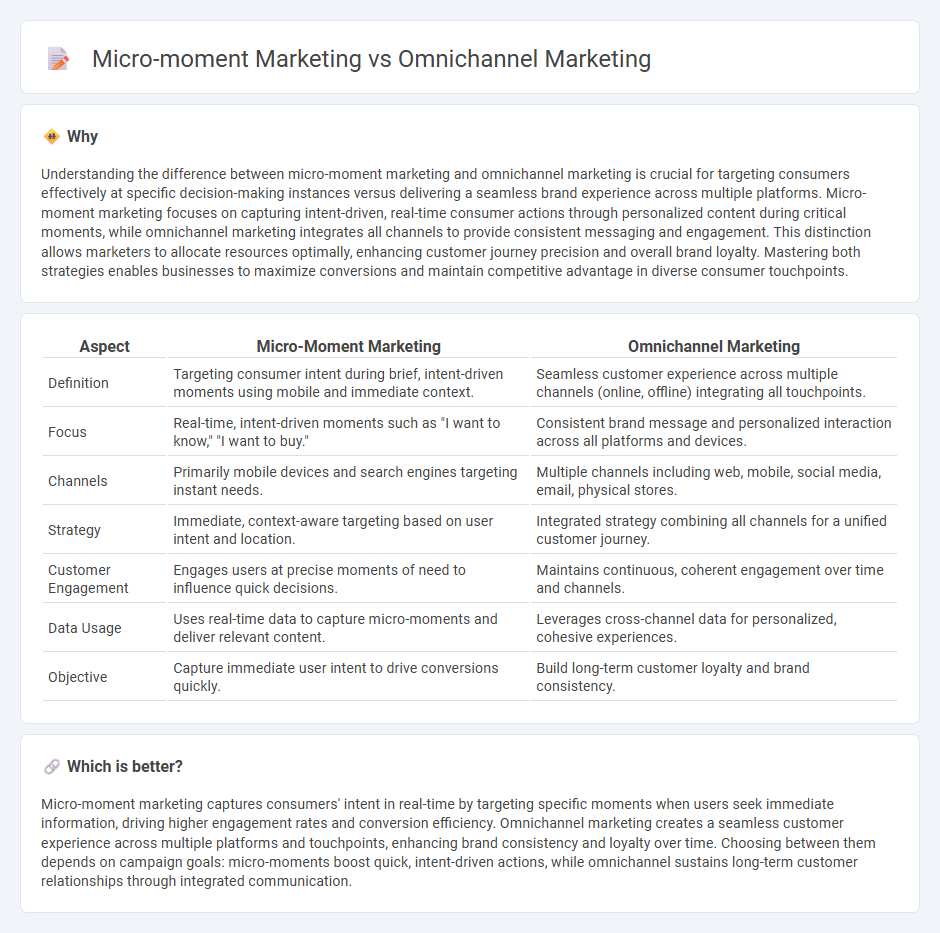
Micro-moment marketing targets consumers' immediate needs by delivering personalized content during critical decision-making instances, leveraging real-time data to capture attention instantly. Omnichannel marketing, in contrast, creates a seamless customer experience across multiple platforms, unifying messaging and interactions to build long-term brand engagement. Explore the nuances of these dynamic strategies to enhance your marketing effectiveness.
Why it is important
Understanding the difference between micro-moment marketing and omnichannel marketing is crucial for targeting consumers effectively at specific decision-making instances versus delivering a seamless brand experience across multiple platforms. Micro-moment marketing focuses on capturing intent-driven, real-time consumer actions through personalized content during critical moments, while omnichannel marketing integrates all channels to provide consistent messaging and engagement. This distinction allows marketers to allocate resources optimally, enhancing customer journey precision and overall brand loyalty. Mastering both strategies enables businesses to maximize conversions and maintain competitive advantage in diverse consumer touchpoints.
Comparison Table
| Aspect | Micro-Moment Marketing | Omnichannel Marketing |
|---|---|---|
| Definition | Targeting consumer intent during brief, intent-driven moments using mobile and immediate context. | Seamless customer experience across multiple channels (online, offline) integrating all touchpoints. |
| Focus | Real-time, intent-driven moments such as "I want to know," "I want to buy." | Consistent brand message and personalized interaction across all platforms and devices. |
| Channels | Primarily mobile devices and search engines targeting instant needs. | Multiple channels including web, mobile, social media, email, physical stores. |
| Strategy | Immediate, context-aware targeting based on user intent and location. | Integrated strategy combining all channels for a unified customer journey. |
| Customer Engagement | Engages users at precise moments of need to influence quick decisions. | Maintains continuous, coherent engagement over time and channels. |
| Data Usage | Uses real-time data to capture micro-moments and deliver relevant content. | Leverages cross-channel data for personalized, cohesive experiences. |
| Objective | Capture immediate user intent to drive conversions quickly. | Build long-term customer loyalty and brand consistency. |
Which is better?
Micro-moment marketing captures consumers' intent in real-time by targeting specific moments when users seek immediate information, driving higher engagement rates and conversion efficiency. Omnichannel marketing creates a seamless customer experience across multiple platforms and touchpoints, enhancing brand consistency and loyalty over time. Choosing between them depends on campaign goals: micro-moments boost quick, intent-driven actions, while omnichannel sustains long-term customer relationships through integrated communication.
Connection
Micro-moment marketing and omnichannel marketing are interconnected through their focus on delivering real-time, personalized customer experiences across multiple touchpoints. Micro-moment marketing targets consumers during specific intent-driven moments, requiring seamless integration with omnichannel strategies to ensure consistent messaging and engagement on devices and platforms. Leveraging data from omnichannel interactions enhances micro-moment targeting accuracy, driving higher conversion rates and customer satisfaction.
Key Terms
omnichannel marketing:
Omnichannel marketing integrates multiple communication channels, such as social media, email, and in-store experiences, to deliver a seamless and consistent customer journey across all touchpoints. It leverages data analytics and customer insights to personalize interactions, enhance brand loyalty, and boost conversion rates by meeting customers wherever they engage. Discover how implementing omnichannel strategies can transform your marketing approach and drive sustained business growth.
Customer Journey
Omnichannel marketing integrates multiple platforms to create a seamless customer journey, ensuring consistent messaging and personalized experiences across touchpoints such as social media, email, and in-store interactions. Micro-moment marketing targets specific real-time customer moments, capturing intent-driven behaviors during moments of need, often on mobile devices. Explore how leveraging both strategies can optimize the customer journey for higher engagement and conversion rates.
Channel Integration
Omnichannel marketing emphasizes seamless channel integration, creating a consistent customer experience across physical stores, websites, social media, and mobile apps to ensure brand coherence. Micro-moment marketing targets specific, intent-rich moments when consumers make quick decisions, leveraging real-time data to deliver personalized content primarily through mobile devices. Explore how optimizing channel strategies can elevate customer engagement and conversion rates.
Source and External Links
What is Omnichannel Marketing? Definition, Tips, and Examples - Omnichannel marketing integrates branding, messaging, and both online and offline consumer touchpoints to create a seamless, consumer-centric experience across channels like stores and websites, enhancing customer engagement and convenience throughout the sales funnel.
Learn about omnichannel marketing and how to develop a strategy - Omnichannel marketing prioritizes a consistent, integrated customer journey across all touchpoints, using data-driven strategies and personalized experiences, differing from multichannel marketing by focusing on customer experience rather than individual channels.
What is Omnichannel Marketing? Definition & Examples - Mailchimp - Omnichannel marketing involves a cohesive presence across multiple online and offline channels with consistent, personalized messaging that reflects customer interactions and enhances retention by creating a unified brand experience.
 dowidth.com
dowidth.com